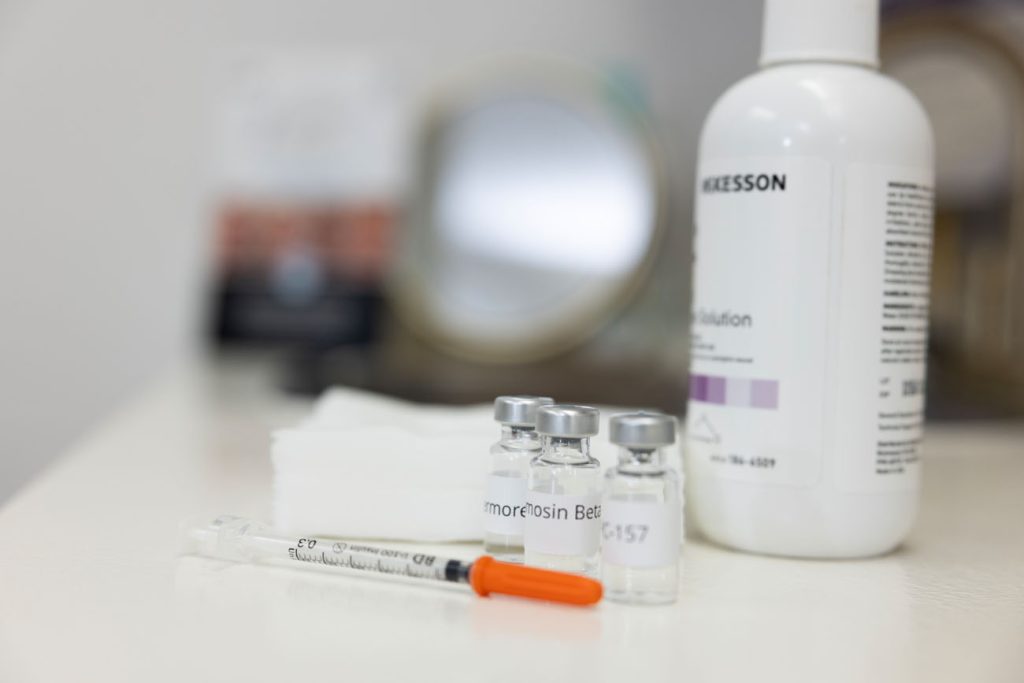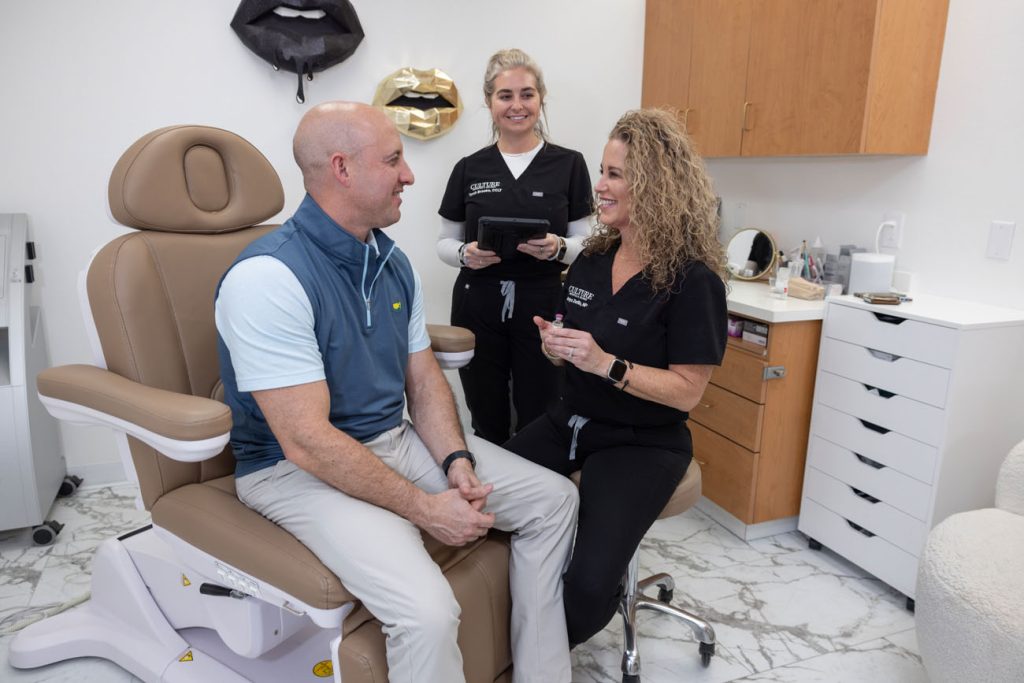The ever-increasing popularity of peptides calls for a review of their efficacy
As a scientist, I realize that one subject does not make a study. It’s not even a drop in the bucket. However, if that one subject is you, then your perspective changes.
Two years ago, I underwent a total knee replacement which happens to be the most common surgery in orthopaedics. Being a pathologically driven person, I wanted to crush the rehab and get back into the gym—and return to work as quickly as possible. For years, I have preached to my patients the importance of nutrition to maximize recovery and prevent complications. A high protein diet, supplements like branch chain amino acids, creatine, vitamins D and C were boxes that I had already checked. So, the obvious question was: is there something else that could harness the body’s own ability to heal and optimize its function? That search lead me to peptides.
Although the use of peptides has been around for decades, their use in regenerative medicine has exponentially increased in the past ten years. It is expected that FDA approval for peptides will increase by 40 percent over the next 10 years as pharmaceutical companies have now realized their value in preventive and regenerative medicine. Some examples of common peptides are oxytocin (used in labor and delivery), insulin (used to treat diabetes), and more recently semaglutide, which is being hailed as one of the greatest weight loss treatments ever. So, what is a peptide? The answer requires a little background information.
The Break Down
If science is not your thing, feel free to skip forward a few paragraphs. A peptide is simply a chain of 10 to 100 amino acids linked together in a sequence. Amino acid chains longer than that are usually called proteins, and proteins will be hundreds of amino acids chains folded up on each other. Proteins are the structural building blocks of the body, while peptides are the signaling mechanism by which cells and organs communicate with each other. Cells and organelles within each cell have receptors on them onto which the peptides can bind and regulate a particular function of that cell or organelle.
Peptides can be used to increase the function of a cell or organ to secrete a desired substance such as a hormone and as such can be more strategic in their respective action. This is much different than taking the end product such as the hormone itself. For instance, one could take GH (growth hormone) which has many desired effects on body composition, reduction in inflammatory mediators such as CRP (C reactive protein), and reduction in triglyceride levels. However, taking the end product hormone can bypass the bodies normal negative feedback mechanisms that keep those hormone levels at their normal physiologic level. In contrast, taking a peptide that mimics the signal to have your body naturally secrete more growth hormone, keeps those negative feedback loops intact and is thus safer and more tactical.

Let’s Talk Healing
I have always had a hard time accepting claims at face value. Claims such as “this product will give you more energy” or “this product will make you look younger” are used so often that they have become cliches. I’m a mechanism guy. I want to know how it works and the science behind it. So, I started my delve into peptides to see what could work for me and my patients.
This included doing personal research, listening to podcasts, and conducting interviews with local experts including Dr. Deb Durst at Revitilyze MD and Anya Zerilla NP at Culture Aesthetics and Wellness.
One of the first peptides we discussed was BPC (body protection compound) 157. It is a 15 amino acid peptide that is very similar to one found in the stomach. It can be taken orally or injected just beneath the skin. The exact mechanisms at the signaling cascade cellular level are still being elucidated however the effects include stimulating fibroblast growth factor, (potent bone marrow stem cells that make collagenous tissue to repair wounds), a decrease in inflammatory markers, and an increase in GH receptors. Orally, it has been used to treat inflammatory bowel disease such as ulcerative colitis.
I asked Dr. Durst about the effects that she has seen with BPC 157 in her clinical practice. “We have seen amazing results in healing time in acute injuries and surgery and even pain reduction in chronic conditions,” she responded. At Culture, Zerilla said, “We have seen no adverse side effects and that the best delivery method is by injection except for GI use”. When asked about site specificity (meaning injecting into the site of injury), Dr. Durst said, “Unless the injury superficial and the needle can be directed by imaging such as with ultrasound, then simple subcutaneous injection into abdomen is effective”. Zerilla echoed the same.
Thymosin beta4 is another repair/regenerative peptide that is frequently used with BPC 157. It is a powerful wound healing peptide that has been shown to increase re-epithelialization (resurfacing of a wound) by 40 to 60 percent. It also increases collagen deposition and angiogenesis (growth of new blood vessels).
Growth Hormone & Weight Loss
As we all age, the amount of growth hormone produced by the body decreases. This results in a reduction in lean muscle mass, slower metabolism, and can have negative effects on energy and sleep. Growth hormone releasing hormone (GHRH) peptides like tesamorelin, ipamorelin, sermorelin, and CJC 1295 stimulate the anterior pituitary in the brain to secrete more growth hormone. The patient is able to realize the benefits of an increase in their own GH while the normal negative feedback loop remains intact which mitigates the possibility of the patient becoming supratherapeutic, meaning you’re over the normal physiological level and entering into where you will have side effects without getting any meaningful additional benefits.
I asked our local practitioners about their use of these GHRH peptides. “Most of my patients don’t come in asking for peptides, but rather have complaints like fatigue, loss of muscle mass, stubborn fat, sleep disturbances and recovery,” said Dr. Durst. “The use of these peptides can markedly change the way my patients feel and look and even sleep”.

My concern would be the possibility of promoting cancer by stimulating its growth. A quick review of the peptide literature came up with no data. Therefore, I went to the data on the end product, the exogenous growth hormone, and found that there are good data to show that it reduces disease and extends life, but there was no reported increase in cancer rates. Zerilla echoed that finding: “I have not seen or heard of any significant side effects or increase in cancer rates with the use of the GHRH peptides”.
Semaglutide has become a very popular weight loss peptide. It was being used in research on dementia and serendipitously patients were found to lose weight. It works by mimicking the GLP 1 (glucagon like peptide 1) receptor which, in the gut, makes you feel full and, in the brain, makes you feel satiated. It seems to work on caloric restriction but there may be other effects that are not understood.
Bringing It All Together
The source of the peptides does matter. Peptides can be made through what is called a recombinant technique or synthesized. The recombinant technique basically induces a bacterium to make the peptide which is then purified. This can be an imperfect purification process that leaves some of the bacterial products behind. These products can cause reactions in patients. A purer form is synthesizing the peptide in a machine. Regardless of the method, the facility should be FDA approved and the product third-party tested to ensure purity and sterility. Therefore, you should be careful obtaining peptides outside the U.S.
Peptide use is growing as clinicians are realizing the positive effects on repair and healing as well as on body composition and, more importantly, on disease prevention and longevity. Research is burgeoning on the use of neurotropic peptides in cognitive decline and neurodegenerative disorders such as dementia. If we shifted our focus in medicine from just treatment with medicines once a disease is encountered, to prevention from the disease actually occurring, we could potentially improve our healthspan (length of time that we are free of disease or disability) and thus our spend in healthcare dollars.
I think that is what we all want, to live better and longer. Peptides appear to offer that opportunity, but it first starts with behavior modification with exercise and nutrition. The number one life hack to improve healthspan is by far and away exercise of various forms with peptides being a subsequent adjunct.
My personal use after my knee replacement certainly made me a believer in peptides. So much so that I used them when my son had his ACL reconstructed which has optimized his recovery. As a result of this personal experience and my own research and review of the data, I encourage many of my patients to consider the use of peptides after injury or surgery in an effort to optimize their recovery. However, as I tell them, if you are considering their use, do your due diligence and research, ask questions about them, and carefully consider your options. Informed health decisions are best. Peptides could just be the key to improving recovery, optimizing health, and potentially improving longevity.
